Employee Motivation: Positive, Negative Factors and Coping Strategies
VerifiedAdded on 2022/12/16
|8
|1742
|23
Report
AI Summary
This report delves into the multifaceted concept of employee motivation within today's dynamic business environment. It begins by defining motivation and exploring its significance in aligning individual goals with organizational objectives. The report then examines Maslow's Hierarchy of Needs and differentiates between intrinsic and extrinsic motivation. It identifies various factors that influence employee experience, including salary, promotion, and work environment, highlighting both positive aspects such as personal commitment and connection with others, and negative aspects like stress, poor management, and limited opportunities. Finally, the report proposes strategies to mitigate negative factors, such as creating a learning culture, providing career support, building effective communication, and conducting engaging activities to improve overall employee satisfaction and productivity. The report concludes by emphasizing the importance of motivation in achieving organizational goals and objectives.
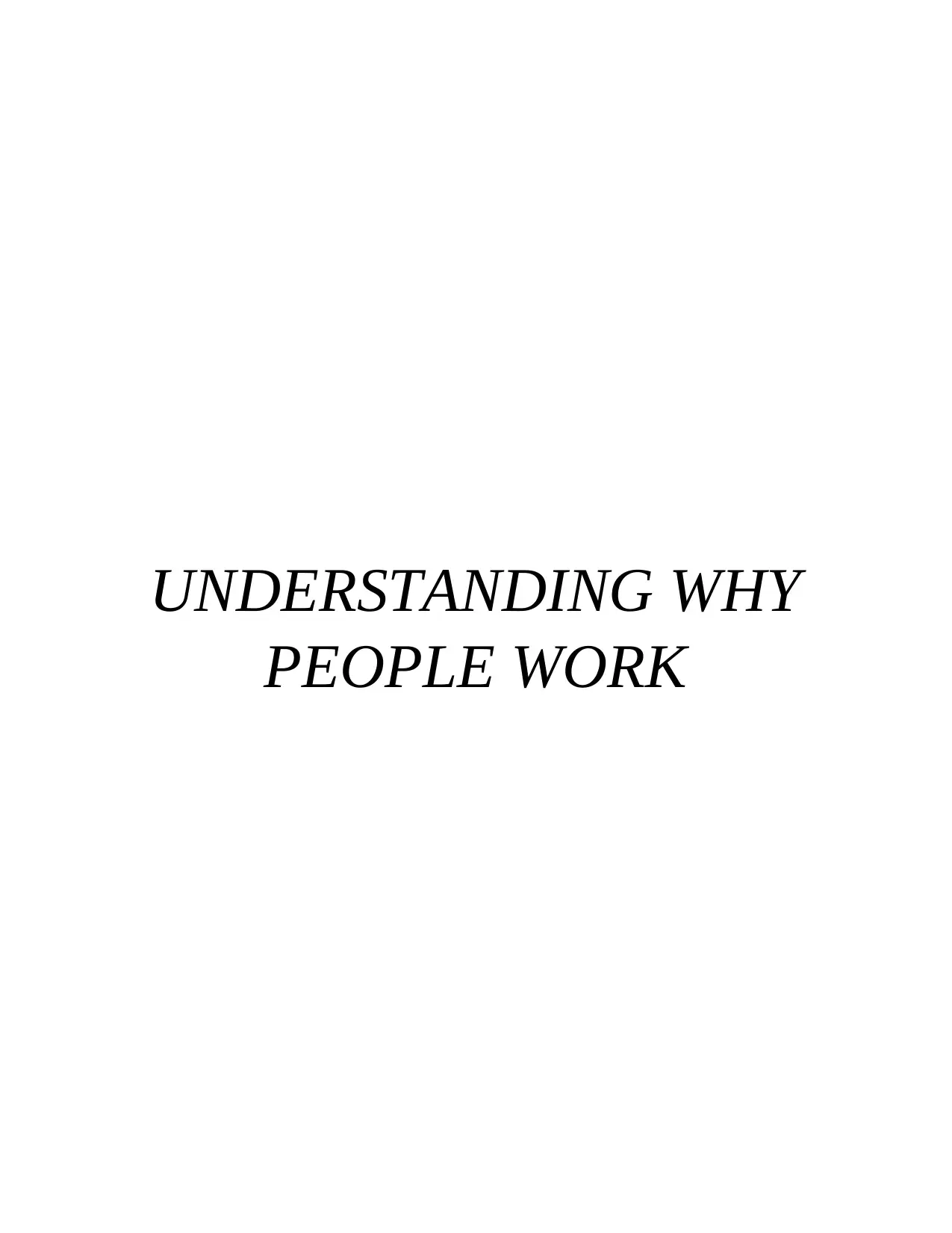
UNDERSTANDING WHY
PEOPLE WORK
PEOPLE WORK
Paraphrase This Document
Need a fresh take? Get an instant paraphrase of this document with our AI Paraphraser
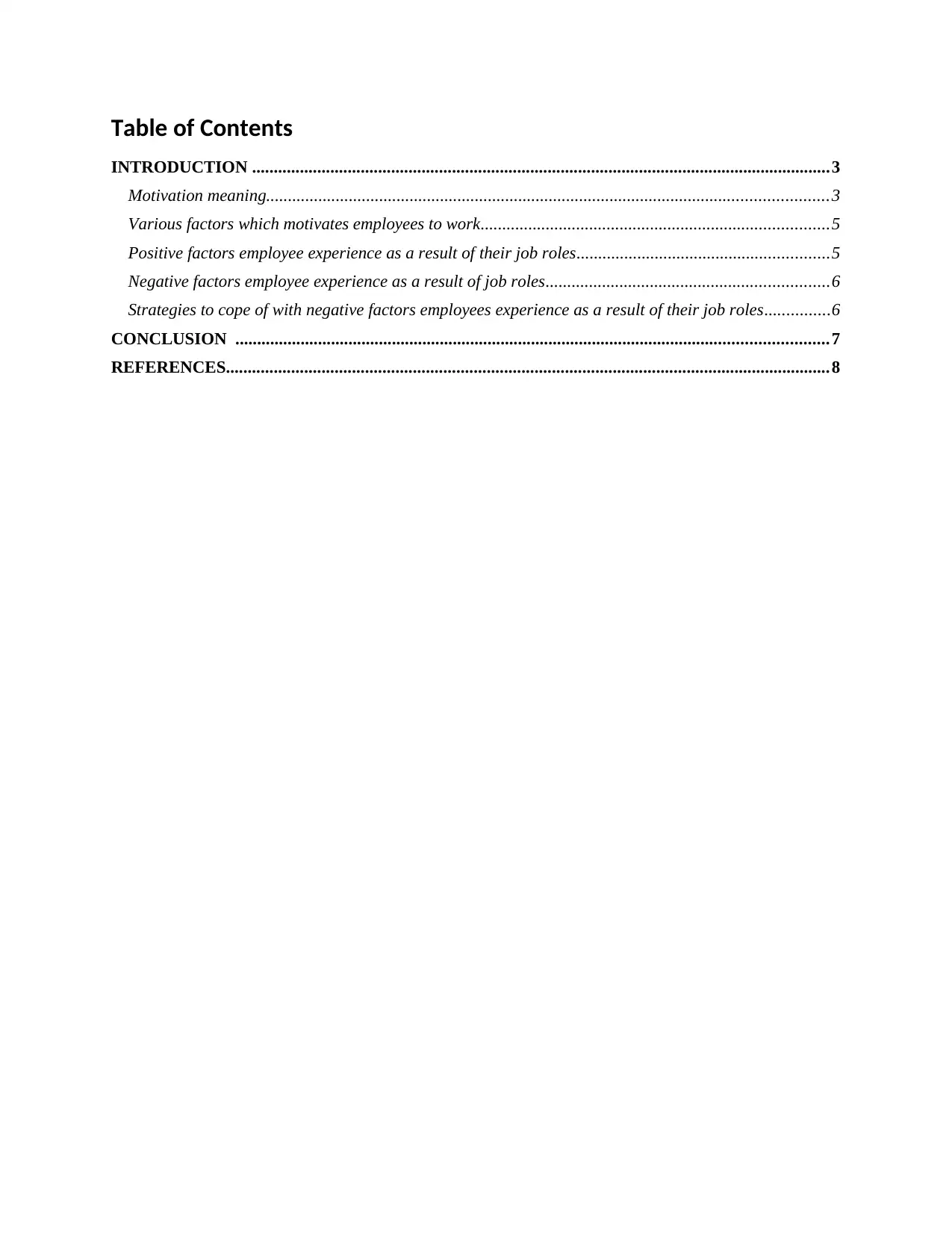
Table of Contents
INTRODUCTION .....................................................................................................................................3
Motivation meaning.................................................................................................................................3
Various factors which motivates employees to work................................................................................5
Positive factors employee experience as a result of their job roles..........................................................5
Negative factors employee experience as a result of job roles.................................................................6
Strategies to cope of with negative factors employees experience as a result of their job roles...............6
CONCLUSION ........................................................................................................................................7
REFERENCES...........................................................................................................................................8
INTRODUCTION .....................................................................................................................................3
Motivation meaning.................................................................................................................................3
Various factors which motivates employees to work................................................................................5
Positive factors employee experience as a result of their job roles..........................................................5
Negative factors employee experience as a result of job roles.................................................................6
Strategies to cope of with negative factors employees experience as a result of their job roles...............6
CONCLUSION ........................................................................................................................................7
REFERENCES...........................................................................................................................................8
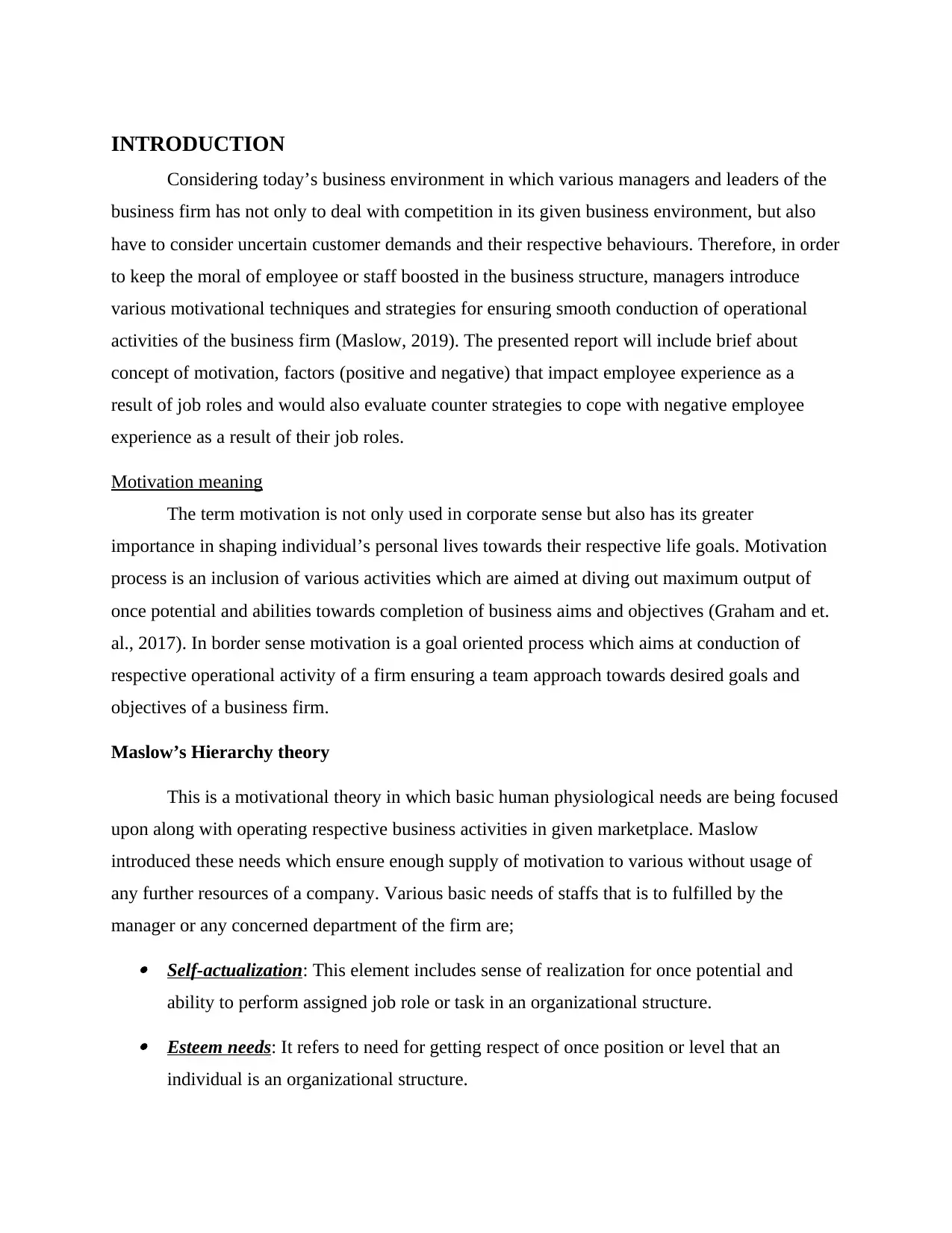
INTRODUCTION
Considering today’s business environment in which various managers and leaders of the
business firm has not only to deal with competition in its given business environment, but also
have to consider uncertain customer demands and their respective behaviours. Therefore, in order
to keep the moral of employee or staff boosted in the business structure, managers introduce
various motivational techniques and strategies for ensuring smooth conduction of operational
activities of the business firm (Maslow, 2019). The presented report will include brief about
concept of motivation, factors (positive and negative) that impact employee experience as a
result of job roles and would also evaluate counter strategies to cope with negative employee
experience as a result of their job roles.
Motivation meaning
The term motivation is not only used in corporate sense but also has its greater
importance in shaping individual’s personal lives towards their respective life goals. Motivation
process is an inclusion of various activities which are aimed at diving out maximum output of
once potential and abilities towards completion of business aims and objectives (Graham and et.
al., 2017). In border sense motivation is a goal oriented process which aims at conduction of
respective operational activity of a firm ensuring a team approach towards desired goals and
objectives of a business firm.
Maslow’s Hierarchy theory
This is a motivational theory in which basic human physiological needs are being focused
upon along with operating respective business activities in given marketplace. Maslow
introduced these needs which ensure enough supply of motivation to various without usage of
any further resources of a company. Various basic needs of staffs that is to fulfilled by the
manager or any concerned department of the firm are; Self-actualization: This element includes sense of realization for once potential and
ability to perform assigned job role or task in an organizational structure. Esteem needs: It refers to need for getting respect of once position or level that an
individual is an organizational structure.
Considering today’s business environment in which various managers and leaders of the
business firm has not only to deal with competition in its given business environment, but also
have to consider uncertain customer demands and their respective behaviours. Therefore, in order
to keep the moral of employee or staff boosted in the business structure, managers introduce
various motivational techniques and strategies for ensuring smooth conduction of operational
activities of the business firm (Maslow, 2019). The presented report will include brief about
concept of motivation, factors (positive and negative) that impact employee experience as a
result of job roles and would also evaluate counter strategies to cope with negative employee
experience as a result of their job roles.
Motivation meaning
The term motivation is not only used in corporate sense but also has its greater
importance in shaping individual’s personal lives towards their respective life goals. Motivation
process is an inclusion of various activities which are aimed at diving out maximum output of
once potential and abilities towards completion of business aims and objectives (Graham and et.
al., 2017). In border sense motivation is a goal oriented process which aims at conduction of
respective operational activity of a firm ensuring a team approach towards desired goals and
objectives of a business firm.
Maslow’s Hierarchy theory
This is a motivational theory in which basic human physiological needs are being focused
upon along with operating respective business activities in given marketplace. Maslow
introduced these needs which ensure enough supply of motivation to various without usage of
any further resources of a company. Various basic needs of staffs that is to fulfilled by the
manager or any concerned department of the firm are; Self-actualization: This element includes sense of realization for once potential and
ability to perform assigned job role or task in an organizational structure. Esteem needs: It refers to need for getting respect of once position or level that an
individual is an organizational structure.
⊘ This is a preview!⊘
Do you want full access?
Subscribe today to unlock all pages.

Trusted by 1+ million students worldwide
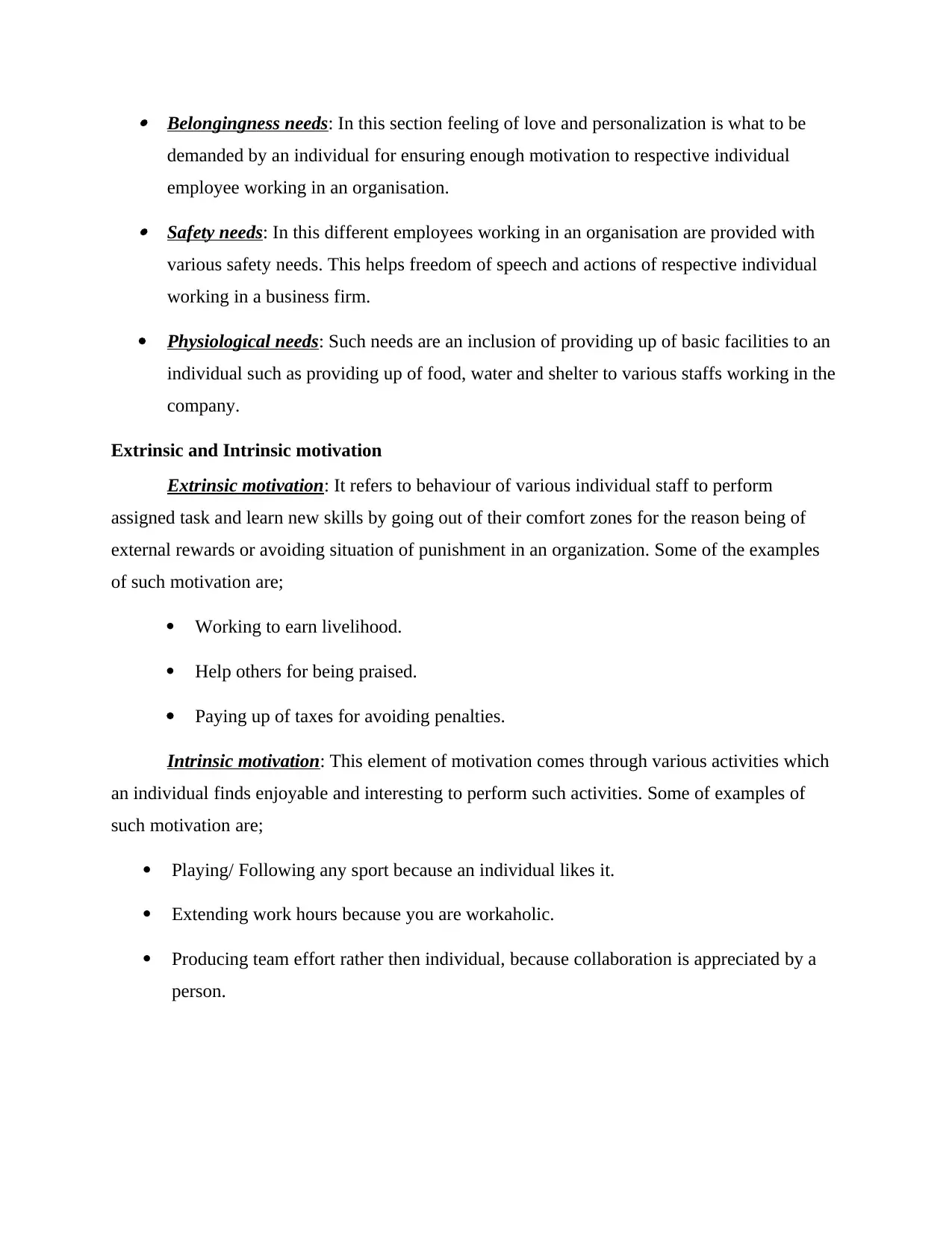
Belongingness needs: In this section feeling of love and personalization is what to be
demanded by an individual for ensuring enough motivation to respective individual
employee working in an organisation. Safety needs: In this different employees working in an organisation are provided with
various safety needs. This helps freedom of speech and actions of respective individual
working in a business firm.
Physiological needs: Such needs are an inclusion of providing up of basic facilities to an
individual such as providing up of food, water and shelter to various staffs working in the
company.
Extrinsic and Intrinsic motivation
Extrinsic motivation: It refers to behaviour of various individual staff to perform
assigned task and learn new skills by going out of their comfort zones for the reason being of
external rewards or avoiding situation of punishment in an organization. Some of the examples
of such motivation are;
Working to earn livelihood.
Help others for being praised.
Paying up of taxes for avoiding penalties.
Intrinsic motivation: This element of motivation comes through various activities which
an individual finds enjoyable and interesting to perform such activities. Some of examples of
such motivation are;
Playing/ Following any sport because an individual likes it.
Extending work hours because you are workaholic.
Producing team effort rather then individual, because collaboration is appreciated by a
person.
demanded by an individual for ensuring enough motivation to respective individual
employee working in an organisation. Safety needs: In this different employees working in an organisation are provided with
various safety needs. This helps freedom of speech and actions of respective individual
working in a business firm.
Physiological needs: Such needs are an inclusion of providing up of basic facilities to an
individual such as providing up of food, water and shelter to various staffs working in the
company.
Extrinsic and Intrinsic motivation
Extrinsic motivation: It refers to behaviour of various individual staff to perform
assigned task and learn new skills by going out of their comfort zones for the reason being of
external rewards or avoiding situation of punishment in an organization. Some of the examples
of such motivation are;
Working to earn livelihood.
Help others for being praised.
Paying up of taxes for avoiding penalties.
Intrinsic motivation: This element of motivation comes through various activities which
an individual finds enjoyable and interesting to perform such activities. Some of examples of
such motivation are;
Playing/ Following any sport because an individual likes it.
Extending work hours because you are workaholic.
Producing team effort rather then individual, because collaboration is appreciated by a
person.
Paraphrase This Document
Need a fresh take? Get an instant paraphrase of this document with our AI Paraphraser
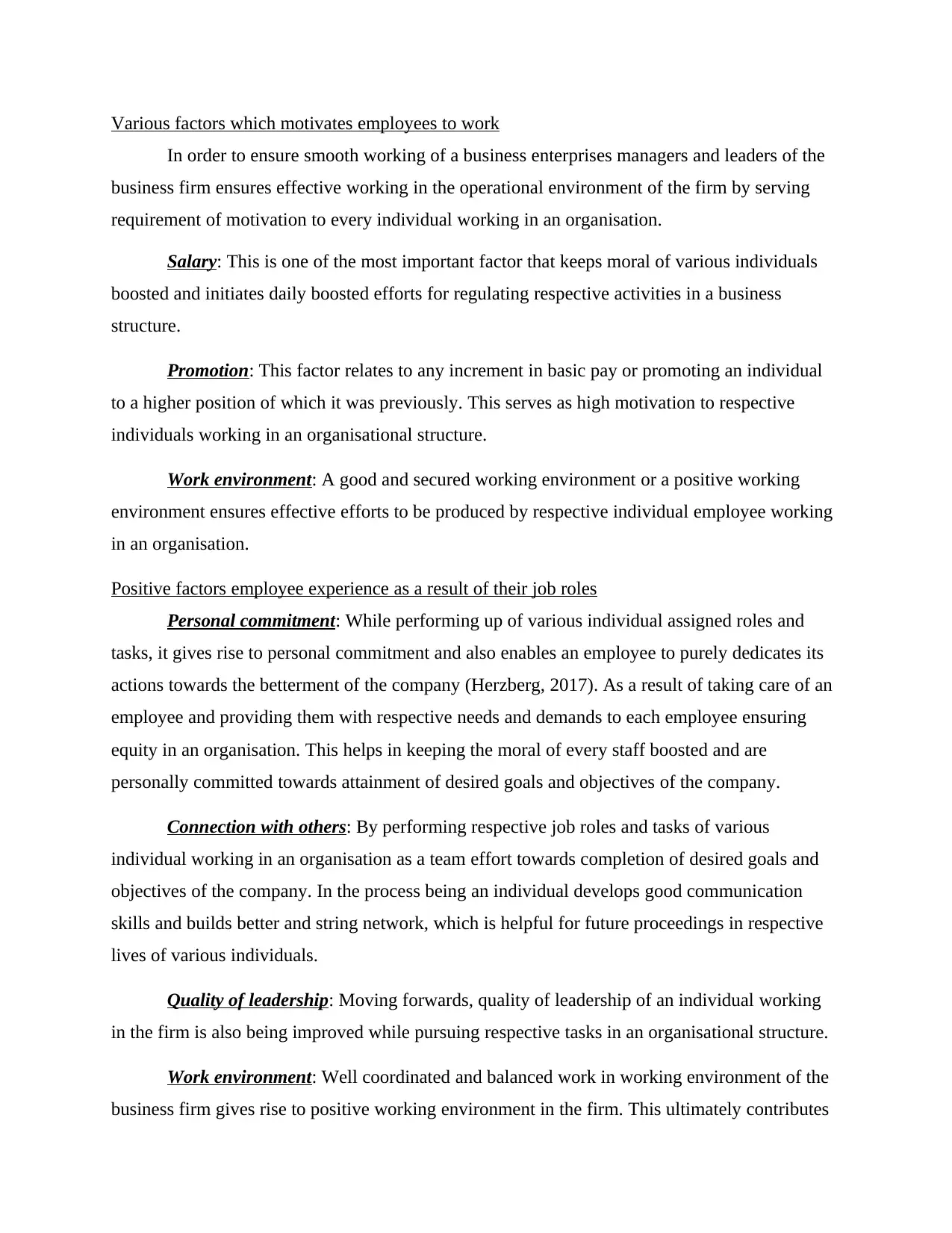
Various factors which motivates employees to work
In order to ensure smooth working of a business enterprises managers and leaders of the
business firm ensures effective working in the operational environment of the firm by serving
requirement of motivation to every individual working in an organisation.
Salary: This is one of the most important factor that keeps moral of various individuals
boosted and initiates daily boosted efforts for regulating respective activities in a business
structure.
Promotion: This factor relates to any increment in basic pay or promoting an individual
to a higher position of which it was previously. This serves as high motivation to respective
individuals working in an organisational structure.
Work environment: A good and secured working environment or a positive working
environment ensures effective efforts to be produced by respective individual employee working
in an organisation.
Positive factors employee experience as a result of their job roles
Personal commitment: While performing up of various individual assigned roles and
tasks, it gives rise to personal commitment and also enables an employee to purely dedicates its
actions towards the betterment of the company (Herzberg, 2017). As a result of taking care of an
employee and providing them with respective needs and demands to each employee ensuring
equity in an organisation. This helps in keeping the moral of every staff boosted and are
personally committed towards attainment of desired goals and objectives of the company.
Connection with others: By performing respective job roles and tasks of various
individual working in an organisation as a team effort towards completion of desired goals and
objectives of the company. In the process being an individual develops good communication
skills and builds better and string network, which is helpful for future proceedings in respective
lives of various individuals.
Quality of leadership: Moving forwards, quality of leadership of an individual working
in the firm is also being improved while pursuing respective tasks in an organisational structure.
Work environment: Well coordinated and balanced work in working environment of the
business firm gives rise to positive working environment in the firm. This ultimately contributes
In order to ensure smooth working of a business enterprises managers and leaders of the
business firm ensures effective working in the operational environment of the firm by serving
requirement of motivation to every individual working in an organisation.
Salary: This is one of the most important factor that keeps moral of various individuals
boosted and initiates daily boosted efforts for regulating respective activities in a business
structure.
Promotion: This factor relates to any increment in basic pay or promoting an individual
to a higher position of which it was previously. This serves as high motivation to respective
individuals working in an organisational structure.
Work environment: A good and secured working environment or a positive working
environment ensures effective efforts to be produced by respective individual employee working
in an organisation.
Positive factors employee experience as a result of their job roles
Personal commitment: While performing up of various individual assigned roles and
tasks, it gives rise to personal commitment and also enables an employee to purely dedicates its
actions towards the betterment of the company (Herzberg, 2017). As a result of taking care of an
employee and providing them with respective needs and demands to each employee ensuring
equity in an organisation. This helps in keeping the moral of every staff boosted and are
personally committed towards attainment of desired goals and objectives of the company.
Connection with others: By performing respective job roles and tasks of various
individual working in an organisation as a team effort towards completion of desired goals and
objectives of the company. In the process being an individual develops good communication
skills and builds better and string network, which is helpful for future proceedings in respective
lives of various individuals.
Quality of leadership: Moving forwards, quality of leadership of an individual working
in the firm is also being improved while pursuing respective tasks in an organisational structure.
Work environment: Well coordinated and balanced work in working environment of the
business firm gives rise to positive working environment in the firm. This ultimately contributes
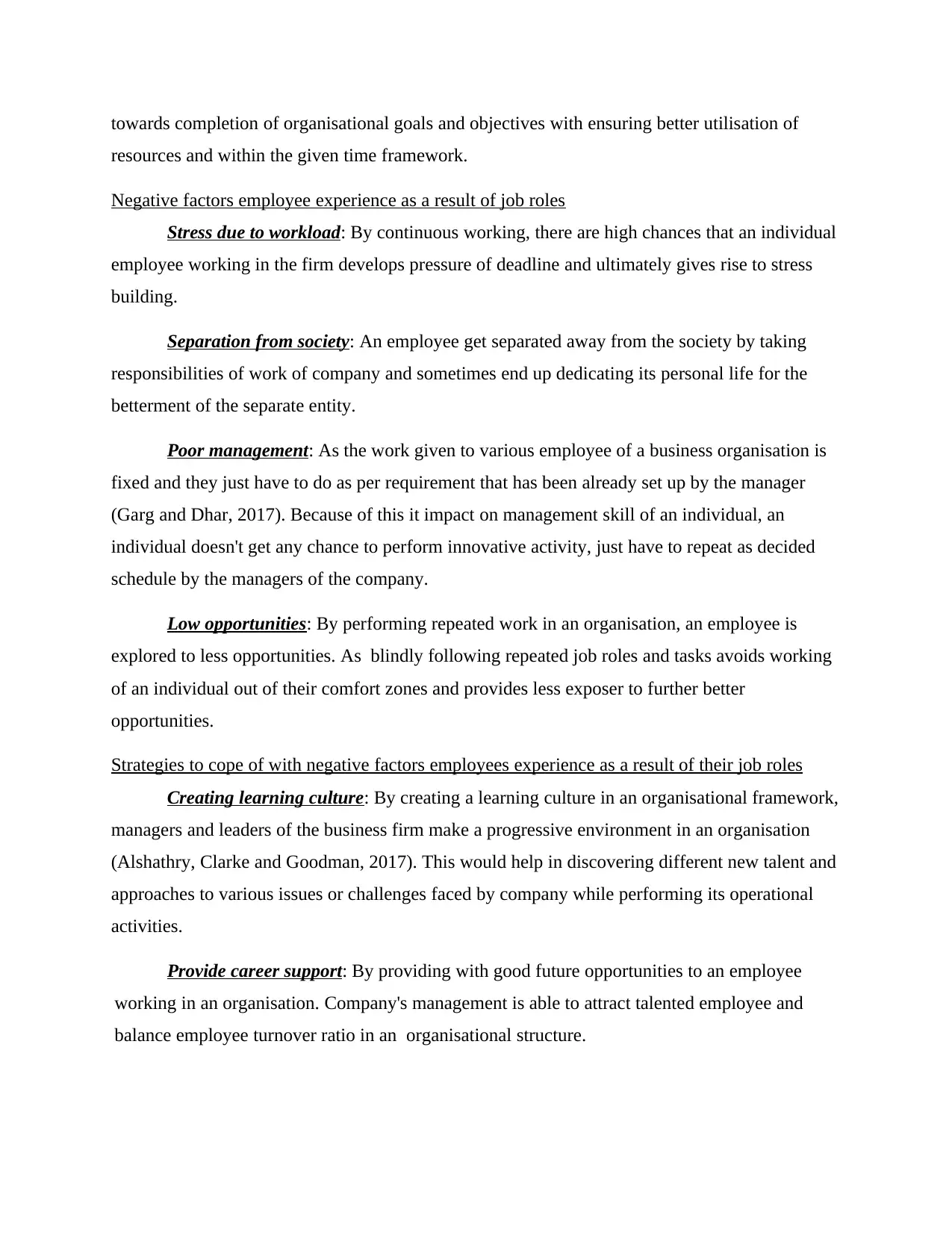
towards completion of organisational goals and objectives with ensuring better utilisation of
resources and within the given time framework.
Negative factors employee experience as a result of job roles
Stress due to workload: By continuous working, there are high chances that an individual
employee working in the firm develops pressure of deadline and ultimately gives rise to stress
building.
Separation from society: An employee get separated away from the society by taking
responsibilities of work of company and sometimes end up dedicating its personal life for the
betterment of the separate entity.
Poor management: As the work given to various employee of a business organisation is
fixed and they just have to do as per requirement that has been already set up by the manager
(Garg and Dhar, 2017). Because of this it impact on management skill of an individual, an
individual doesn't get any chance to perform innovative activity, just have to repeat as decided
schedule by the managers of the company.
Low opportunities: By performing repeated work in an organisation, an employee is
explored to less opportunities. As blindly following repeated job roles and tasks avoids working
of an individual out of their comfort zones and provides less exposer to further better
opportunities.
Strategies to cope of with negative factors employees experience as a result of their job roles
Creating learning culture: By creating a learning culture in an organisational framework,
managers and leaders of the business firm make a progressive environment in an organisation
(Alshathry, Clarke and Goodman, 2017). This would help in discovering different new talent and
approaches to various issues or challenges faced by company while performing its operational
activities.
Provide career support: By providing with good future opportunities to an employee
working in an organisation. Company's management is able to attract talented employee and
balance employee turnover ratio in an organisational structure.
resources and within the given time framework.
Negative factors employee experience as a result of job roles
Stress due to workload: By continuous working, there are high chances that an individual
employee working in the firm develops pressure of deadline and ultimately gives rise to stress
building.
Separation from society: An employee get separated away from the society by taking
responsibilities of work of company and sometimes end up dedicating its personal life for the
betterment of the separate entity.
Poor management: As the work given to various employee of a business organisation is
fixed and they just have to do as per requirement that has been already set up by the manager
(Garg and Dhar, 2017). Because of this it impact on management skill of an individual, an
individual doesn't get any chance to perform innovative activity, just have to repeat as decided
schedule by the managers of the company.
Low opportunities: By performing repeated work in an organisation, an employee is
explored to less opportunities. As blindly following repeated job roles and tasks avoids working
of an individual out of their comfort zones and provides less exposer to further better
opportunities.
Strategies to cope of with negative factors employees experience as a result of their job roles
Creating learning culture: By creating a learning culture in an organisational framework,
managers and leaders of the business firm make a progressive environment in an organisation
(Alshathry, Clarke and Goodman, 2017). This would help in discovering different new talent and
approaches to various issues or challenges faced by company while performing its operational
activities.
Provide career support: By providing with good future opportunities to an employee
working in an organisation. Company's management is able to attract talented employee and
balance employee turnover ratio in an organisational structure.
⊘ This is a preview!⊘
Do you want full access?
Subscribe today to unlock all pages.

Trusted by 1+ million students worldwide
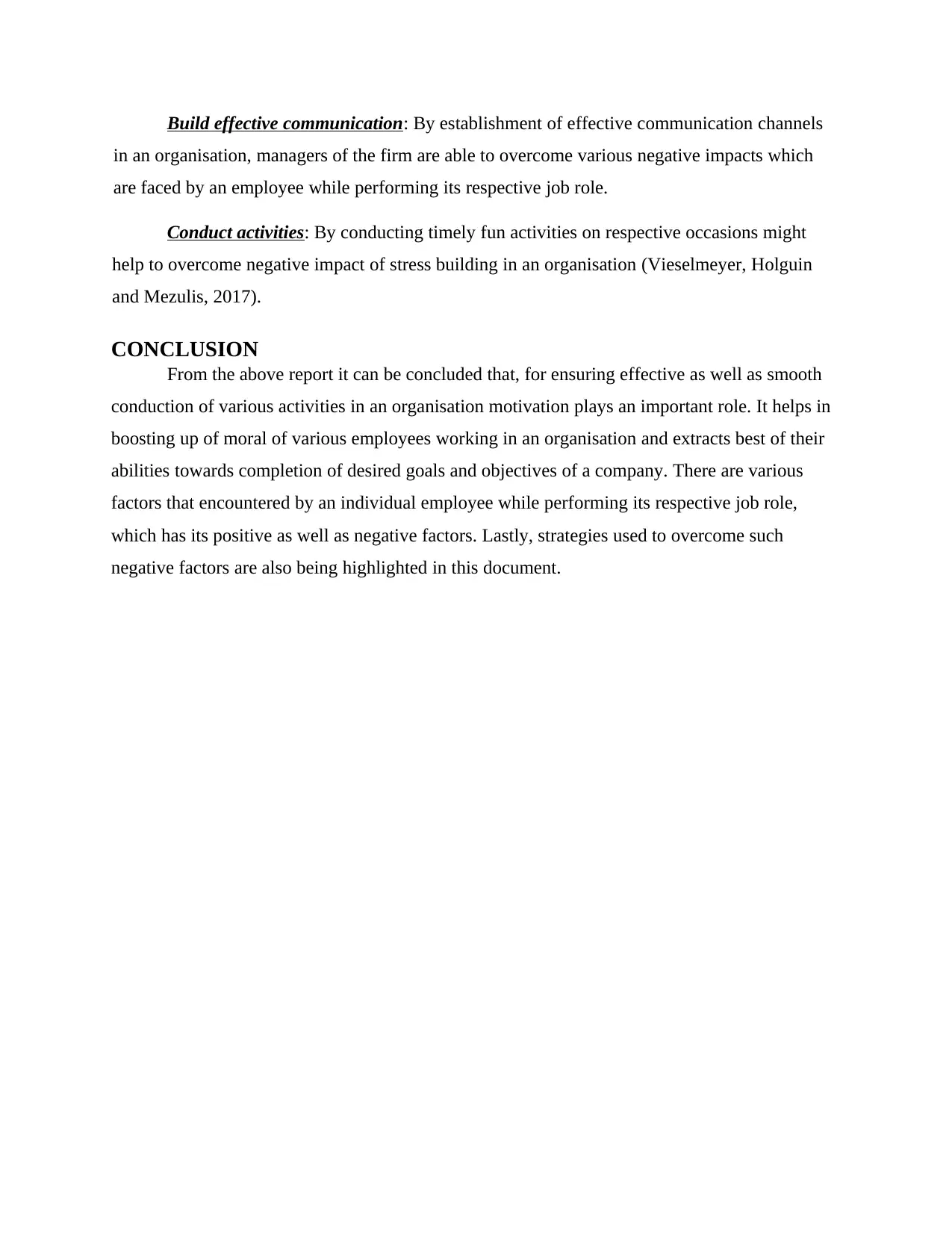
Build effective communication: By establishment of effective communication channels
in an organisation, managers of the firm are able to overcome various negative impacts which
are faced by an employee while performing its respective job role.
Conduct activities: By conducting timely fun activities on respective occasions might
help to overcome negative impact of stress building in an organisation (Vieselmeyer, Holguin
and Mezulis, 2017).
CONCLUSION
From the above report it can be concluded that, for ensuring effective as well as smooth
conduction of various activities in an organisation motivation plays an important role. It helps in
boosting up of moral of various employees working in an organisation and extracts best of their
abilities towards completion of desired goals and objectives of a company. There are various
factors that encountered by an individual employee while performing its respective job role,
which has its positive as well as negative factors. Lastly, strategies used to overcome such
negative factors are also being highlighted in this document.
in an organisation, managers of the firm are able to overcome various negative impacts which
are faced by an employee while performing its respective job role.
Conduct activities: By conducting timely fun activities on respective occasions might
help to overcome negative impact of stress building in an organisation (Vieselmeyer, Holguin
and Mezulis, 2017).
CONCLUSION
From the above report it can be concluded that, for ensuring effective as well as smooth
conduction of various activities in an organisation motivation plays an important role. It helps in
boosting up of moral of various employees working in an organisation and extracts best of their
abilities towards completion of desired goals and objectives of a company. There are various
factors that encountered by an individual employee while performing its respective job role,
which has its positive as well as negative factors. Lastly, strategies used to overcome such
negative factors are also being highlighted in this document.
Paraphrase This Document
Need a fresh take? Get an instant paraphrase of this document with our AI Paraphraser
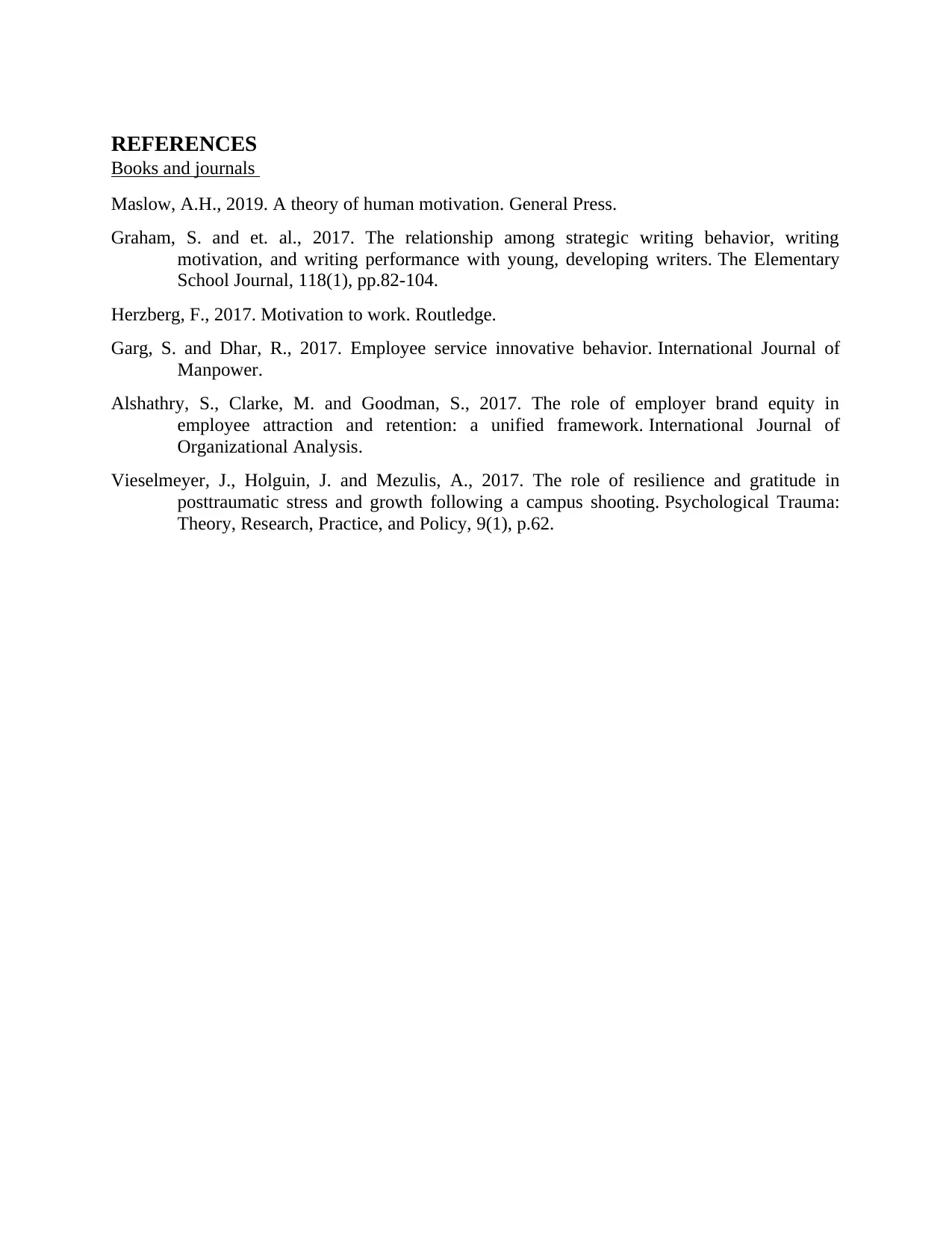
REFERENCES
Books and journals
Maslow, A.H., 2019. A theory of human motivation. General Press.
Graham, S. and et. al., 2017. The relationship among strategic writing behavior, writing
motivation, and writing performance with young, developing writers. The Elementary
School Journal, 118(1), pp.82-104.
Herzberg, F., 2017. Motivation to work. Routledge.
Garg, S. and Dhar, R., 2017. Employee service innovative behavior. International Journal of
Manpower.
Alshathry, S., Clarke, M. and Goodman, S., 2017. The role of employer brand equity in
employee attraction and retention: a unified framework. International Journal of
Organizational Analysis.
Vieselmeyer, J., Holguin, J. and Mezulis, A., 2017. The role of resilience and gratitude in
posttraumatic stress and growth following a campus shooting. Psychological Trauma:
Theory, Research, Practice, and Policy, 9(1), p.62.
Books and journals
Maslow, A.H., 2019. A theory of human motivation. General Press.
Graham, S. and et. al., 2017. The relationship among strategic writing behavior, writing
motivation, and writing performance with young, developing writers. The Elementary
School Journal, 118(1), pp.82-104.
Herzberg, F., 2017. Motivation to work. Routledge.
Garg, S. and Dhar, R., 2017. Employee service innovative behavior. International Journal of
Manpower.
Alshathry, S., Clarke, M. and Goodman, S., 2017. The role of employer brand equity in
employee attraction and retention: a unified framework. International Journal of
Organizational Analysis.
Vieselmeyer, J., Holguin, J. and Mezulis, A., 2017. The role of resilience and gratitude in
posttraumatic stress and growth following a campus shooting. Psychological Trauma:
Theory, Research, Practice, and Policy, 9(1), p.62.
1 out of 8
Related Documents
Your All-in-One AI-Powered Toolkit for Academic Success.
+13062052269
info@desklib.com
Available 24*7 on WhatsApp / Email
![[object Object]](/_next/static/media/star-bottom.7253800d.svg)
Unlock your academic potential
Copyright © 2020–2025 A2Z Services. All Rights Reserved. Developed and managed by ZUCOL.
